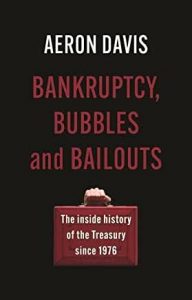Former prime minister (briefly) Liz Truss might not have been the biggest economic brain, but was she right to argue that there is such as thing as ‘the Treasury View’ and further that it hasn’t served the country well? Many people across the political spectrum would agree. I briefly worked in the Treasury many years ago and was certainly quickly socialized into certain rule-of-thumb beliefs – free trade is good, hypothecating taxes is bad, etc. I have some thoughts about how to test the Treasury View hypothesis, particularly the claim about the short-termism it imposes on economic policy. Meanwhile I’ve been reading a few books. One was Sam Beer’s old overview of how the Treasury operated in the 1950s. Another is a new book, Bankruptcy, Bubbles and Bailouts: the inside history of the Treasury since 1976, by Aeron Davis.
It was both an interesting and an incredibly frustrating read. The book draws on a series of over 50 interviews which included some absolutely key insiders – ministers and officials – and a few experienced external commentators. It would be hard to draw up a better list. However, the author has his own strong views and does not distinguish clearly between his commentary and his interviewees’ perspectives. Indeed, some of his commentary on interviewees I know strikes me as just wrong, failing to distinguish between their actions as principled civil servants serving the government of the day and their personal views about privatization or deregulation. I found myself wishing I could just read the interview transcripts instead.
It isn’t that there are no good authorial observations; on the contrary, he points out the inconsistency of globalising and deregulating the financial markets at the same time as trying to control the growth of the money supply (that was happening in my era); or that the hit to manufacturing from exchange rate appreciation in the early 80s coincided with deliberate policy actions that harmed industry and helped finance. Indeed, the main theme of the book is the financialization of the economy – although it seems to me this had as much to do with political choices as Treasury dogma. There is a particularly interesting chapter about the financial crisis and the reorganisation of financial supervision.
However, former Perm Sec Nick Macpherson is one believer in the idea of a Treasury view, setting out its key elements in a speech he gave in 2014, all centred around the asserted limits to what government can accomplish in economic policy. I think there’s still something to pursue in documenting not so much what it is as why it is, and how it lasts despite the huge changes in the economy and rapid turnover in personnel, and what the implications are for better economic management. The book is well worth reading but it is a view through a particular lens.

